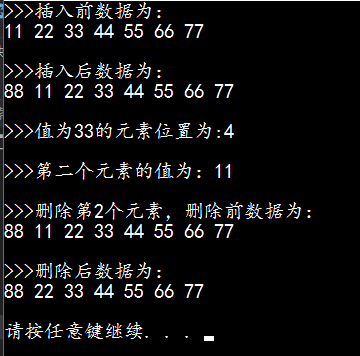- 算法竞赛备考冲刺必刷题(C++) | 洛谷 P8814 解密
热爱编程的通信人
算法c++开发语言
本文分享的必刷题目是从蓝桥云课、洛谷、AcWing等知名刷题平台精心挑选而来,并结合各平台提供的算法标签和难度等级进行了系统分类。题目涵盖了从基础到进阶的多种算法和数据结构,旨在为不同阶段的编程学习者提供一条清晰、平稳的学习提升路径。欢迎大家订阅我的专栏:算法题解:C++与Python实现!附上汇总贴:算法竞赛备考冲刺必刷题(C++)|汇总【题目来源】洛谷:P8814[CSP-J2022]解密-洛
- 【C++】atoi和std::stoi
bluebonnet27
编程语言#C++c++算法开发语言
两个将字符串转为int的方法atoi(C语言)atoi是C库中的一个函数,它定义在头文件里。其作用是把一个字符串转换为对应的整数。/*Convertastringtoaninteger.*/externintatoi(constchar*__nptr)__THROW__attribute_pure____nonnull((1))__wur;转换的原则如下:此函数接收一个以空字符'\0'结尾的字符串
- 008 【入门】算法和数据结构简介
要天天开心啊
算法专栏算法数据结构
算法与数据结构系统概览|[算法]-[基础]-[通用]一、算法分类与应用1.硬计算类算法|[算法]-[中级]-[通用]特点应用场景复杂度特征-精确求解问题-可能带来较高计算复杂度-大厂笔试/面试-ACM竞赛-所有程序员岗位必考⏱️通常为O(n)~O(n²)//[示例]快速排序算法-分治思想核心实现publicvoidquickSort(int[]arr,intleft,intright){if(le
- 单双链表及其反转
醇醛酸醚酮酯
开发语言
一,空指针的补充1.空指针的定义在C语言中,空指针通常被定义为NULL,或者在C++中为nullptr。它的本质是一个指针,指向无效的地址,用来表示一个指针当前没有指向有效的内存空间。空指针并不指向实际的内存地址,因此可以用于表示指针没有被初始化或者没有指向任何有效的对象。例如:int*ptr=NULL;//ptr是一个空指针在许多编译器中,空指针通常会被定义为0,或者一个特定的常量值(例如0x0
- 009 【入门】单双链表及其反转-堆栈诠释
要天天开心啊
算法专栏算法链表
链表与堆栈系统详解|[数据结构]-[中级]-[通用]一、基础概念与内存模型1.按值传递vs按引用传递|[Java]-[基础]-[内存]//[典型错误示例]-Java中的引用传递陷阱voidmodify(Nodenode){node=node.next;//[警告]错误!仅修改局部引用的指向,不影响原始链表}//[正确做法]-通过引用修改对象内部状态voidrealModify(Nodenode){
- Ansible——lookup,过滤器
凤凰战士芭比Q
Ansibleansiblelinux
文章目录Ansible——lookup,过滤器lookup读取文件lookup生成随机密码lookup读取环境变量lookup读取Linux命令的执行结果lookup读取template变量替换后的文件lookup读取配置文件lookup读取DNS解析的值过滤器过滤器使用的位置过滤器对普通变量的操作过滤器对文件路径的操作过滤器对字符串变量的操作过滤器对JSON的操作过滤器对数据结构的操作过滤器的链
- 【C++】String的使用
nanguochenchuan
C++c++开发语言
字符串基础概念std::stringvsC风格字符串std::string是C++标准库提供的字符串类,相比C风格的char*具有明显优势:自动内存管理丰富的成员函数安全的边界检查支持运算符重载#include//必须包含的头文件std::strings1;//空字符串std::strings2="Hello";//直接初始化charcstr[]="World";std::strings3(cst
- 【数据结构】顺序表
nanguochenchuan
数据结构数据结构
一,顺序表1.顺序表的定义顺序表是一种线性表的数据结构,它的数据元素按照一定次序依次存储在计算机存储器中,使用连续的存储空间来存储。顺序表中每个数据元素的位置都有一个序号,这个序号也称为元素在顺序表中的下标。顺序表的特点是:元素的逻辑顺序与物理顺序相同,支持随机访问,插入和删除元素的时间复杂度为O(n),查找元素的时间复杂度为O(1)。2.优点与不足优点是访问速度快,因为它的元素在内存中是连续存储
- 【Linux】ghb工具
nanguochenchuan
Linux操作系统linux运维服务器
GDB简介GDB(GNUDebugger)是Linux系统中最强大的命令行调试工具,由GNU项目开发。作为程序员调试C/C++程序的利器,GDB能帮助你:定位程序崩溃原因分析程序运行状态跟踪变量值变化检测内存错误安装与配置安装方法#Ubuntu/Debiansudoaptinstallgdb#CentOS/RHELsudoyuminstallgdb#ArchLinuxsudopacman-Sgdb
- 区块链技术概述:从比特币到Web3.0
闲人编程
Python区块链50讲区块链web3python元宇宙比特币安全
目录区块链技术概述:从比特币到Web3.0引言:数字革命的下一篇章1.区块链技术基础1.1区块链定义与核心特征1.2区块链数据结构可视化2.比特币:区块链的开端2.1比特币的核心创新2.2比特币交易生命周期3.以太坊与智能合约革命3.1以太坊的核心创新3.2智能合约执行流程4.Web3.0:互联网的新范式4.1Web3.0的核心特征4.2Web3技术栈5.Python实现简易区块链系统5.1区块类
- c++ io操作(文件的读取与写入)
galaxy_strive
C++Studyc++开发语言
1文件的读取//文件操作模式//ios::app追加模式//ios::ate文件打开后定位到文件末尾//ios::in打开文件用于读取//ios::out打开文件用于写入//ios::trunc如果该文件已经存在,其内容将在打开之前被截断,即把文件长度设置为0//读取文件示例intmain(){fstreamfile("./io.txt",ios::in);//文件是否正常打开if(file.is
- c++常见英文单词(自用)
叫我六胖子
c++英文c++
c++常见英文单词application应用程式应用、应用程序applicationframework应用程式框架、应用框架应用程序框架architecture架构、系统架构体系结构argument引数(传给函式的值)。叁见parameter叁数、实质叁数、实叁、自变量array阵列数组arrowoperatorarrow(箭头)运算子箭头操作符assembly装配件assemblylanguag
- 【C++算法竞赛】前缀和+桶数组
YLCHUP
C++算法技巧算法c++开发语言数据结构哈希算法c语言笔记
文章目录1.前缀和基础2.算法原理3.例题讲解[P1114“非常男女”计划](https://www.luogu.com.cn/problem/P1114)[P11965[GESP202503七级]等价消除](https://www.luogu.com.cn/problem/P11965)[P10724[GESP202406七级]区间乘积](https://www.luogu.com.cn/pro
- 构建四则运算解析器:字符串处理与计算逻辑实战
大熊小清新
本文还有配套的精品资源,点击获取简介:四则运算解析器是将包含四则运算符号的字符串表达式转化为可执行计算的程序。它对编程初学者而言是理解编程逻辑和语法分析的基础。通过理解四则运算的优先级规则,实现输入处理、词法分析、语法分析和计算步骤,可以采用递归下降解析或堆栈解析等方法。本解析器的实现涉及字符串处理、数据结构的运用,有助于学习者掌握编程语言的底层工作方式,提升编程技能和问题解决能力。1.四则运算解
- 【C++】命令模式
目录一、模式核心概念与结构二、C++实现示例:遥控器与家电控制三、命令模式的关键特性四、应用场景五、命令模式与其他设计模式的关系六、C++标准库中的命令模式应用七、优缺点分析八、实战案例:数据库事务命令九、实现注意事项如果这篇文章对你有所帮助,渴望获得你的一个点赞!命令模式(CommandPattern)是一种【行为型】设计模式,它将请求封装为对象,从而使你可以用不同的请求对客户端进行参数化,对请
- C++生成静态库和动态库
什么是静态库和动态库在项目开发中,或多或少地需要使用到第三方(非编译器提供)的程序库,使用第三方的程序库能够减少重复造轮子的工作,提高开发效率。本文将介绍如何把自己的写的程序制作为程序库提供给他人使用,学会制作程序库后,自然也就会掌握了如何使用他人提供的程序库了。程序库从使用方式上分为两种,静态库和动态库。当我们在使用第三方提供的静态库时,当编译程序时,需要将我们自己写的程序和第三方库链接在一起形
- 博图SCL语言中用户自定义数据类型(UDT)使用详解
控界小宇宙
西门子PLC博途(TIAPortal)SCL自动化运维程序人生开发语言
博图SCL语言中用户自定义数据类型(UDT)使用详解一、UDT概述用户自定义数据类型(UDT)是TIAPortal中强大的结构化工具,允许将多个相关变量组合成单一数据结构。UDT本质是可重用的数据模板,具有以下核心优势:结构化组织:将逻辑相关的变量分组管理代码重用:一次定义,多处使用维护便捷:修改UDT定义自动更新所有实例接口标准化:确保数据传递一致性二、UDT创建步骤(图文详解)1.创建UDT项
- C++智能指针编程实例
lixzest
c++开发语言
智能指针是C++11引入的重要特性,用于自动管理动态分配的内存,防止内存泄漏。下面介绍几种高级智能指针编程实例。1.共享所有权模式(shared_ptr)循环引用问题及解决方案#include#includeclassB;//前向声明classA{public:std::shared_ptrb_ptr;~A(){std::couta_ptr;//这里会导致循环引用~B(){std::cout();
- C++ Lambda表达式详解:从入门到精通
Jay_515
c++Lambda
Lambda表达式是C11引入的最重要特性之一,它彻底改变了我们在C中编写函数对象的方式。本文将带你全面掌握Lambda表达式的使用技巧!1.什么是Lambda表达式?Lambda表达式是C++11引入的一种匿名函数对象,它允许我们在需要函数的地方内联定义函数,无需单独命名。Lambda的出现极大简化了代码,特别是在使用STL算法时。为什么需要Lambda?简化代码:避免为简单操作单独编写函数对象
- cJSON 源码解析
1.概述cJSON是一个轻量级的C语言JSON解析库,支持JSON数据的解析和生成。它采用单一头文件和源文件的设计,易于集成到项目中。主要特性完整的JSON支持(解析和生成)内存管理自动化支持格式化输出支持自定义内存分配器跨平台兼容2.核心数据结构2.1cJSON结构体typedefstructcJSON{structcJSON*next;//指向下一个兄弟节点structcJSON*prev;/
- mongodb和redis的区别:
huangbfeng
mongodbredis数据库
1、内存管理机制Redis数据全部存在内存,定期写入磁盘,当内存不够时,可以选择指定的LRU算法删除数据。MongoDB数据存在内存,由linux系统mmap实现,当内存不够时,只将热点数据放入内存,其他数据存在磁盘。2、支持的数据结构Redis支持的数据结构丰富,包括hash、set、list等。MongoDB数据结构比较单一,但是支持丰富的数据表达,索引,最类似关系型数据库,支持的查询语言非常
- MongoDB框架零基础入门
码农研究僧
Python100天精通全栈mongodbnosql数据库
目录前言1.安装配置2.关启配置3.基本概念4.基本操作4.1创建集合4.2删除集合4.3插入文档4.4更新文档4.5删除文档4.6查询文档前言先科普讲解一下NoSQL(notonlysql)本身NoSQL非关系型数据库就具备了ACID(原子性、一致性、持久性、隔离性)数据持久化一般还是要使用关系型数据库,内存的数据库使用检索MongoDB是C++编写,一个基于分布式文件存储的开源数据库系统。将其
- C++学习笔记(2)——高精度减法
「已注销」
C++学习笔记(每周至少3篇)C++c++
上篇文章我们了解了高精度加法,今天我们来讲减法。和加法一样,减法也是模拟小学减法竖式:先用数组存下被减数和减数:①如果a[i]b,a[i+1]还可以向a[i+2]借位。借位后a[i+1]等于9,而b[i+1]最大为9。我们来看一下高精度减法的思路:①高精度数的读取存储:使用字符串方式读取,然后转成整型数组,为方便计算,进行逆向存储。②模拟竖式进行减法:相同位置进行相减,不够减时进行借位③去除前导0
- GPS-SDR-SIM与HackONE的融合:C++实现的高效GPS模拟
m0_57781768
c++开发语言
GPS-SDR-SIM与HackONE的融合:C++实现的高效GPS模拟前言在现代导航技术中,全球定位系统(GPS)无疑是最重要的工具之一。然而,随着技术的发展,GPS模拟器在安全测试、导航系统开发和教育等领域的应用也越来越广泛。GPS-SDR-SIM是一个开源的GPS模拟软件,通过软件定义无线电(SDR)技术,能够生成GPS信号,并用于各种GPS接收器的测试。HackONE是一种流行的SDR硬件
- Java基础:流程控制语句:条件、循环和跳转
越重天
Java基础入门教程Java宝藏java开发语言java流程控制语句零到一学Java
前言Java中的流程控制语句其实和C、C++一样,在Java中,流程控制会涉及到包括if-else、while、do-while、for、return、break以及选择语句switch。下面以此进行分析。流程控制语句,分为三大类:条件语句,循环语句和跳转语句,如下图所示:1.条件语句条件语句可根据不同的条件执行不同的语句。包括if条件语句与switch多分支语句。1.1if语句if语句
- C++高精度除以高精度
洛谷题真多
算法c++算法
高精度除以高精度的问题,在计算机科学中是一个常见的挑战,特别是在处理非常大的数字时,这些数字超出了标准数据类型(如int或longlong)的范围。这里,我们将详细解释一种常见的方法来解决这个问题:模拟手工除法。基本思路模拟手工除法的过程,即将一个高精度数(被除数)除以另一个高精度数(除数),并逐位计算商和余数。步骤详解初始化:设定被除数A和除数B(均为高精度数
- C++ 数据类型
風清掦
C++c++经验分享
使用编程语言进行编程时,需要用到各种变量来存储各种信息。变量保留的是它所存储的值的内存位置。这意味着,当创建一个变量时,就会在内存中保留一些空间。可能需要存储各种数据类型(比如字符型、宽字符型、整型、浮点型、双浮点型、布尔型等)的信息,操作系统会根据变量的数据类型,来分配内存和决定在保留内存中存储什么。基本的内置类型C++提供了种类丰富的内置数据类型和用户自定义的数据类型。下表列出了七种基本的C+
- 【基数排序介绍】
wdwc2
算法设计算法数据结构排序算法
文章目录前言一、基数排序是什么?二、基数排序的步骤(LSD低位优先)1.找出最大数的位数2.对每一位进行排序(从最低位到最高位)三、C++实现1.主函数:基数排序实现四、时间复杂度分析五、基数排序的适用场景六、与其他排序算法对比七、扩展:处理负数的思路总结前言在处理大规模整数排序问题时,比较类排序(如快速排序)可能无法发挥最优性能。本篇博客将详细介绍一种非比较类排序算法:基数排序(RadixSor
- C语言到C++快速入门
前言:通过前面的学习,我们了解了C语言的一些性质和用法,为了更加深入的学习C,我们可以向C++进阶,探究C++的知识世界,相信可以收获不少知识!一.C语言和C++的关系:起源与发展:C语言是由DennisRitchie在1970年代初期开发的,它最初是为了重新设计UNIX操作系统而创建的。C++则是在C语言的基础上发展而来的,由BjarneStroustrup在1980年代初期开始设计,其目标是增
- C# 与vb.net 的Dictionary(字典)的键、值排序
chinaherolts2008
c#开发语言vb.net教程
vb.net教程https://www.xin3721.com/eschool/vbnetxin3721/原文地址VB和VB.NET的大致区别_copico的博客-CSDN博客_vbnet和vb的语法区别VisualBasic.NET是MicrosoftVisualStudio.NET套件中主要组成部分之一。.NET版本的VisualBasic增加了更多特性,而且演化为完全面向对象(就像C++)的
- Spring中@Value注解,需要注意的地方
无量
springbean@Valuexml
Spring 3以后,支持@Value注解的方式获取properties文件中的配置值,简化了读取配置文件的复杂操作
1、在applicationContext.xml文件(或引用文件中)中配置properties文件
<bean id="appProperty"
class="org.springframework.beans.fac
- mongoDB 分片
开窍的石头
mongodb
mongoDB的分片。要mongos查询数据时候 先查询configsvr看数据在那台shard上,configsvr上边放的是metar信息,指的是那条数据在那个片上。由此可以看出mongo在做分片的时候咱们至少要有一个configsvr,和两个以上的shard(片)信息。
第一步启动两台以上的mongo服务
&nb
- OVER(PARTITION BY)函数用法
0624chenhong
oracle
这篇写得很好,引自
http://www.cnblogs.com/lanzi/archive/2010/10/26/1861338.html
OVER(PARTITION BY)函数用法
2010年10月26日
OVER(PARTITION BY)函数介绍
开窗函数 &nb
- Android开发中,ADB server didn't ACK 解决方法
一炮送你回车库
Android开发
首先通知:凡是安装360、豌豆荚、腾讯管家的全部卸载,然后再尝试。
一直没搞明白这个问题咋出现的,但今天看到一个方法,搞定了!原来是豌豆荚占用了 5037 端口导致。
参见原文章:一个豌豆荚引发的血案——关于ADB server didn't ACK的问题
简单来讲,首先将Windows任务进程中的豌豆荚干掉,如果还是不行,再继续按下列步骤排查。
&nb
- canvas中的像素绘制问题
换个号韩国红果果
JavaScriptcanvas
pixl的绘制,1.如果绘制点正处于相邻像素交叉线,绘制x像素的线宽,则从交叉线分别向前向后绘制x/2个像素,如果x/2是整数,则刚好填满x个像素,如果是小数,则先把整数格填满,再去绘制剩下的小数部分,绘制时,是将小数部分的颜色用来除以一个像素的宽度,颜色会变淡。所以要用整数坐标来画的话(即绘制点正处于相邻像素交叉线时),线宽必须是2的整数倍。否则会出现不饱满的像素。
2.如果绘制点为一个像素的
- 编码乱码问题
灵静志远
javajvmjsp编码
1、JVM中单个字符占用的字节长度跟编码方式有关,而默认编码方式又跟平台是一一对应的或说平台决定了默认字符编码方式;2、对于单个字符:ISO-8859-1单字节编码,GBK双字节编码,UTF-8三字节编码;因此中文平台(中文平台默认字符集编码GBK)下一个中文字符占2个字节,而英文平台(英文平台默认字符集编码Cp1252(类似于ISO-8859-1))。
3、getBytes()、getByte
- java 求几个月后的日期
darkranger
calendargetinstance
Date plandate = planDate.toDate();
SimpleDateFormat df = new SimpleDateFormat("yyyy-MM-dd");
Calendar cal = Calendar.getInstance();
cal.setTime(plandate);
// 取得三个月后时间
cal.add(Calendar.M
- 数据库设计的三大范式(通俗易懂)
aijuans
数据库复习
关系数据库中的关系必须满足一定的要求。满足不同程度要求的为不同范式。数据库的设计范式是数据库设计所需要满足的规范。只有理解数据库的设计范式,才能设计出高效率、优雅的数据库,否则可能会设计出错误的数据库.
目前,主要有六种范式:第一范式、第二范式、第三范式、BC范式、第四范式和第五范式。满足最低要求的叫第一范式,简称1NF。在第一范式基础上进一步满足一些要求的为第二范式,简称2NF。其余依此类推。
- 想学工作流怎么入手
atongyeye
jbpm
工作流在工作中变得越来越重要,很多朋友想学工作流却不知如何入手。 很多朋友习惯性的这看一点,那了解一点,既不系统,也容易半途而废。好比学武功,最好的办法是有一本武功秘籍。研究明白,则犹如打通任督二脉。
系统学习工作流,很重要的一本书《JBPM工作流开发指南》。
本人苦苦学习两个月,基本上可以解决大部分流程问题。整理一下学习思路,有兴趣的朋友可以参考下。
1 首先要
- Context和SQLiteOpenHelper创建数据库
百合不是茶
androidContext创建数据库
一直以为安卓数据库的创建就是使用SQLiteOpenHelper创建,但是最近在android的一本书上看到了Context也可以创建数据库,下面我们一起分析这两种方式创建数据库的方式和区别,重点在SQLiteOpenHelper
一:SQLiteOpenHelper创建数据库:
1,SQLi
- 浅谈group by和distinct
bijian1013
oracle数据库group bydistinct
group by和distinct只了去重意义一样,但是group by应用范围更广泛些,如分组汇总或者从聚合函数里筛选数据等。
譬如:统计每id数并且只显示数大于3
select id ,count(id) from ta
- vi opertion
征客丶
macoprationvi
进入 command mode (命令行模式)
按 esc 键
再按 shift + 冒号
注:以下命令中 带 $ 【在命令行模式下进行】,不带 $ 【在非命令行模式下进行】
一、文件操作
1.1、强制退出不保存
$ q!
1.2、保存
$ w
1.3、保存并退出
$ wq
1.4、刷新或重新加载已打开的文件
$ e
二、光标移动
2.1、跳到指定行
数字
- 【Spark十四】深入Spark RDD第三部分RDD基本API
bit1129
spark
对于K/V类型的RDD,如下操作是什么含义?
val rdd = sc.parallelize(List(("A",3),("C",6),("A",1),("B",5))
rdd.reduceByKey(_+_).collect
reduceByKey在这里的操作,是把
- java类加载机制
BlueSkator
java虚拟机
java类加载机制
1.java类加载器的树状结构
引导类加载器
^
|
扩展类加载器
^
|
系统类加载器
java使用代理模式来完成类加载,java的类加载器也有类似于继承的关系,引导类是最顶层的加载器,它是所有类的根加载器,它负责加载java核心库。当一个类加载器接到装载类到虚拟机的请求时,通常会代理给父类加载器,若已经是根加载器了,就自己完成加载。
虚拟机区分一个Cla
- 动态添加文本框
BreakingBad
文本框
<script> var num=1; function AddInput() { var str=""; str+="<input
- 读《研磨设计模式》-代码笔记-单例模式
bylijinnan
java设计模式
声明: 本文只为方便我个人查阅和理解,详细的分析以及源代码请移步 原作者的博客http://chjavach.iteye.com/
public class Singleton {
}
/*
* 懒汉模式。注意,getInstance如果在多线程环境中调用,需要加上synchronized,否则存在线程不安全问题
*/
class LazySingleton
- iOS应用打包发布常见问题
chenhbc
iosiOS发布iOS上传iOS打包
这个月公司安排我一个人做iOS客户端开发,由于急着用,我先发布一个版本,由于第一次发布iOS应用,期间出了不少问题,记录于此。
1、使用Application Loader 发布时报错:Communication error.please use diagnostic mode to check connectivity.you need to have outbound acc
- 工作流复杂拓扑结构处理新思路
comsci
设计模式工作算法企业应用OO
我们走的设计路线和国外的产品不太一样,不一样在哪里呢? 国外的流程的设计思路是通过事先定义一整套规则(类似XPDL)来约束和控制流程图的复杂度(我对国外的产品了解不够多,仅仅是在有限的了解程度上面提出这样的看法),从而避免在流程引擎中处理这些复杂的图的问题,而我们却没有通过事先定义这样的复杂的规则来约束和降低用户自定义流程图的灵活性,这样一来,在引擎和流程流转控制这一个层面就会遇到很
- oracle 11g新特性Flashback data archive
daizj
oracle
1. 什么是flashback data archive
Flashback data archive是oracle 11g中引入的一个新特性。Flashback archive是一个新的数据库对象,用于存储一个或多表的历史数据。Flashback archive是一个逻辑对象,概念上类似于表空间。实际上flashback archive可以看作是存储一个或多个表的所有事务变化的逻辑空间。
- 多叉树:2-3-4树
dieslrae
树
平衡树多叉树,每个节点最多有4个子节点和3个数据项,2,3,4的含义是指一个节点可能含有的子节点的个数,效率比红黑树稍差.一般不允许出现重复关键字值.2-3-4树有以下特征:
1、有一个数据项的节点总是有2个子节点(称为2-节点)
2、有两个数据项的节点总是有3个子节点(称为3-节
- C语言学习七动态分配 malloc的使用
dcj3sjt126com
clanguagemalloc
/*
2013年3月15日15:16:24
malloc 就memory(内存) allocate(分配)的缩写
本程序没有实际含义,只是理解使用
*/
# include <stdio.h>
# include <malloc.h>
int main(void)
{
int i = 5; //分配了4个字节 静态分配
int * p
- Objective-C编码规范[译]
dcj3sjt126com
代码规范
原文链接 : The official raywenderlich.com Objective-C style guide
原文作者 : raywenderlich.com Team
译文出自 : raywenderlich.com Objective-C编码规范
译者 : Sam Lau
- 0.性能优化-目录
frank1234
性能优化
从今天开始笔者陆续发表一些性能测试相关的文章,主要是对自己前段时间学习的总结,由于水平有限,性能测试领域很深,本人理解的也比较浅,欢迎各位大咖批评指正。
主要内容包括:
一、性能测试指标
吞吐量、TPS、响应时间、负载、可扩展性、PV、思考时间
http://frank1234.iteye.com/blog/2180305
二、性能测试策略
生产环境相同 基准测试 预热等
htt
- Java父类取得子类传递的泛型参数Class类型
happyqing
java泛型父类子类Class
import java.lang.reflect.ParameterizedType;
import java.lang.reflect.Type;
import org.junit.Test;
abstract class BaseDao<T> {
public void getType() {
//Class<E> clazz =
- 跟我学SpringMVC目录汇总贴、PDF下载、源码下载
jinnianshilongnian
springMVC
----广告--------------------------------------------------------------
网站核心商详页开发
掌握Java技术,掌握并发/异步工具使用,熟悉spring、ibatis框架;
掌握数据库技术,表设计和索引优化,分库分表/读写分离;
了解缓存技术,熟练使用如Redis/Memcached等主流技术;
了解Ngin
- the HTTP rewrite module requires the PCRE library
流浪鱼
rewrite
./configure: error: the HTTP rewrite module requires the PCRE library.
模块依赖性Nginx需要依赖下面3个包
1. gzip 模块需要 zlib 库 ( 下载: http://www.zlib.net/ )
2. rewrite 模块需要 pcre 库 ( 下载: http://www.pcre.org/ )
3. s
- 第12章 Ajax(中)
onestopweb
Ajax
index.html
<!DOCTYPE html PUBLIC "-//W3C//DTD XHTML 1.0 Transitional//EN" "http://www.w3.org/TR/xhtml1/DTD/xhtml1-transitional.dtd">
<html xmlns="http://www.w3.org/
- Optimize query with Query Stripping in Web Intelligence
blueoxygen
BO
http://wiki.sdn.sap.com/wiki/display/BOBJ/Optimize+query+with+Query+Stripping+in+Web+Intelligence
and a very straightfoward video
http://www.sdn.sap.com/irj/scn/events?rid=/library/uuid/40ec3a0c-936
- Java开发者写SQL时常犯的10个错误
tomcat_oracle
javasql
1、不用PreparedStatements 有意思的是,在JDBC出现了许多年后的今天,这个错误依然出现在博客、论坛和邮件列表中,即便要记住和理解它是一件很简单的事。开发者不使用PreparedStatements的原因可能有如下几个: 他们对PreparedStatements不了解 他们认为使用PreparedStatements太慢了 他们认为写Prepar
- 世纪互联与结盟有感
阿尔萨斯
10月10日,世纪互联与(Foxcon)签约成立合资公司,有感。
全球电子制造业巨头(全球500强企业)与世纪互联共同看好IDC、云计算等业务在中国的增长空间,双方迅速果断出手,在资本层面上达成合作,此举体现了全球电子制造业巨头对世纪互联IDC业务的欣赏与信任,另一方面反映出世纪互联目前良好的运营状况与广阔的发展前景。
众所周知,精于电子产品制造(世界第一),对于世纪互联而言,能够与结盟
